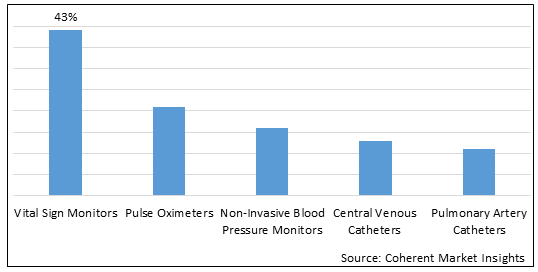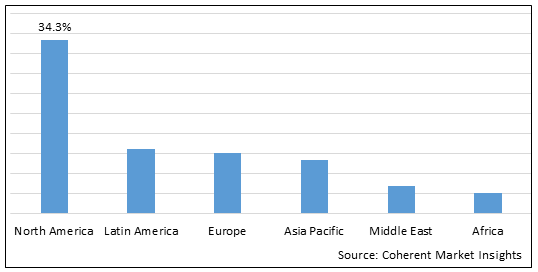Hemodynamic monitoring means determining the functional status of the cardiovascular system as it responds to acute stress such as myocardial infarction and cardiogenic shock. Hemodynamic systems continuously monitor the movement of blood and the pressures being exerted in the veins, arteries, and chambers of the heart. Hemodynamic monitoring system based on the invasive measurement of systemic, pulmonary arterial and venous pressures, and of cardiac output. Invasive hemodynamic pressure monitoring permits continuous assessment of the status of critically ill patients and their response to ongoing therapy, thus providing information essential for more precise diagnosis and prompt correction of a problem.
The global hemodynamic monitoring systems market is estimated to be valued at US$ 1,094.5 million in 2022 and is expected to exhibit a CAGR of 6.6% during the forecast period (2022-2030).
Figure 1. Global Hemodynamic Monitoring Systems Market Share (%), by Product Type, 2022

To learn more about this report, Request sample copy
Global Hemodynamic Monitoring Systems Market - Drivers
Adoption of inorganic strategies such as product launches by key market players are expected to drive the global hemodynamic monitoring systems market over the forecast period. For instance, in May 2019, LiDCo Group, a subsidiary of Masimo, a medical technology company, announced that they had launched LiDCO rapid v3. LiDCO rapid v3 is a non-invasive hemodynamic monitoring system which is used to monitor cardiac output.
Hemodynamic Monitoring Systems Market Report Coverage
| Report Coverage | Details | ||
|---|---|---|---|
| Base Year: | 2021 | Market Size in 2022: | US$ 1,094.5 Mn |
| Historical Data for: | 2017 to 2020 | Forecast Period: | 2022 to 2030 |
| Forecast Period 2022 to 2030 CAGR: | 6.6% | 2030 Value Projection: | US$ 1,826.3 Mn |
| Geographies covered: |
|
||
| Segments covered: |
|
||
| Companies covered: |
Edwards Lifesciences Corporation, ICU Medical, Inc., PULSION Medical Systems SE, Koninklijke Philips N.V., General Electric, TytoCare Ltd., Getinge AB., Nonin, Masimo, Baxter, OMRON Corporation, B. Braun Melsungen AG, Medtronic, Dragerwerk AG & Co. KGaA, Nihon Kohden Corporation, Schwarzer Cardiotek GmbH, Osypka Medical GmbH, and Tensys Medical Inc. |
||
| Growth Drivers: |
|
||
| Restraints & Challenges: |
|
||
Uncover macros and micros vetted on 75+ parameters: Get instant access to report
Figure 2. Global Hemodynamic Monitoring Systems Market Value (US$ Million), by Region, 2022

To learn more about this report, Request sample copy
Global Hemodynamic Monitoring Systems Market – Impact of Coronavirus (COVID-19) Pandemic
Since the COVID-19 virus outbreak in December 2019, the disease has spread to over 100 countries across the globe and the World Health Organization had declared it a public health emergency on January 30, 2020.
COVID-19 can affect the economy in three main ways: by directly affecting production and demand of drugs, by creating disruptions in distribution channels, and through its financial impact on firms and financial markets. Due to nationwide lockdowns, several countries, such as China, India, Saudi Arabia, U.A.E., Egypt, and others, are facing problems with regards to the transportation of drugs from one place to another.
However, the COVID-19 pandemic had a positive impact on the global hemodynamic monitoring systems market. For instance, in April 2020, Health Canada, the regulatory authority of Canada, announced that they had approved the use of Edwards’ HemoSphere platform for management of COVID-19 patients. This platform will measure and track different vital signs that help to manage blood flow and oxygenation in critically ill patients, like those who are being treated for COVID-19. It will also monitor the fluid levels in patients as it has several tools for monitoring fluid levels. Considering the rapidly changing and complex nature of critically ill patients with COVID-19, the availability of continuous hemodynamic information can help clinicians determine the right intervention to help keep patients stabilized.
Global Hemodynamic Monitoring Systems Market: Key Developments
Adoption of inorganic strategies such as acquisition by the key market players is expected to drive the global hemodynamic monitoring systems market over the forecast period. For instance, in September 2019, Baxter, a healthcare company, announced that they had acquired Cheetah Medical, a provider of non-invasive hemodynamic monitoring technologies, to expand specialized patient monitoring portfolio. This acquisition will enhance Baxter’s products and therapies with a non-invasive hemodynamic monitoring system used for fluid management.
Global Hemodynamic Monitoring Systems Market: Restraint
Increasing number of product recalls by regulatory authorities such as the U.S. Food and Drug Administration is the major factor that is expected to hinder growth of the global hemodynamic monitoring systems market. For instance, in January 2021, the U.S. Food and Drug Administration recalled class 2 device cogent hemodynamic monitoring system, which was manufactured by ICU Medical, Inc., a medical device company. The product was recalled due to a potential software issue in which the display had shown the incorrect continuous cardiac output (CCO) values after pulse Oximeters calibration.
Global Hemodynamic Monitoring Systems Market - Key Players
Major players operating in the global hemodynamic monitoring systems market include Edwards Lifesciences Corporation, ICU Medical, Inc., PULSION Medical Systems SE, Koninklijke Philips N.V., General Electric, TytoCare Ltd., Getinge AB., Nonin, Masimo, Baxter, OMRON Corporation, B. Braun Melsungen AG, Medtronic, Dragerwerk AG & Co. KGaA, Nihon Kohden Corporation, Schwarzer Cardiotek GmbH, Osypka Medical GmbH, and Tensys Medical Inc.
Share
Share
Missing comfort of reading report in your local language? Find your preferred language :
Transform your Strategy with Exclusive Trending Reports :
Frequently Asked Questions
Select a License Type
Credibility and Certifications

860519526

9001:2015
27001:2022


Joining thousands of companies around the world committed to making the Excellent Business Solutions.
View All Our Clients
US Reciprocal Tax Impact Analysis On Hemodynamic Monitoring Systems Market
Stay updated on tariff changes with expert insights and timely information